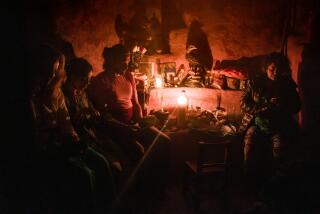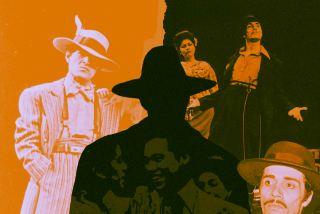Fancy Dancer
- Share via
Liz Campos is of Pueblo-Tewa Indian and Aztec descent. She and her three children live in Los Angeles, and every weekend they attend local pow-wows where her children take part in traditional dances. Campos, who made and assembled son Roman’s costume, talked with MARY G. WENTZ about rediscovering the family’s cultural roots through the dances, songs, drums and regalia that make up a pow- wow gathering.
I was born in Los Angeles and so were the children. They are doing well because they know who they are in their hearts. The children have been dancing and participating at pow- wowsfor four years; it took two years to put the regalia together.
My oldest, Jose, is 17 and sits at the drum and sings Indian songs. He was the one who got us involved in discovering who we are as Indian people. When he was 13, he came to me, saying that we need to do something about our cultural roots. I said OK, but I really didn’t know how to begin the process. I am an urban Indian. I was not reared with Indian traditions. I have been living in the white’s man’s world all of my life.
I began talking with my aunts in Santa Ana and they directed me to our roots with stories from past generations. Then my family became involved with the pow- wow circuit.
I design and construct the clothing part of the regalia for my children, which consists of sewing ribbons and delicate appliques to the fabric. However, I purchased Roman’s double bustle from a trading post in Michigan. Jose makes all of the feather and beadwork for Roman, 11, and his sister Stefanie, 15.
Roman is a Southern fancy traditional dancer. Fast and intricate footwork is employed and body movements are used to interpret the songs.
Because of the pow- wows, we have an extended family; my children have mentors, and as a family we are learning about where we come from. I take a lot of pride in watching the children drum, sing and dance. Finally, I feel connected to my people.
*
Roach: A part of a warrior’s headdress. The beadwork distinguishes families; each design is particular to a specific family.
*
Beaded medallion, beadwork by Liz.
*
Ribbon shirt: Traditionally, these shirts were made from buckskin, but the tradespeople introduced colored fabrics to the Indians. Now colored fabrics are worn to stand out in pow- wows.
*
Breast plate: Breast plates were worn by warriors as protective shields. They are made of beads and leather.
*
Fancy apron: A part of the warrior’s regalia, made of satin and feather appliques.
*
Shaggies: Footwear made of Icelandic sheepskin, worn for warmth and protection.
*
Headband: A part of a warrior’s headdress.
*
Eagle feathers: Eagles are said to carry the prayers to the Great Spirit. Eagle feathers are worn fo protection.
*
Medicine wheel: A wrapped shawl fringe, given traditionally to a warrior by a medicine man for protection.
*
Cuffs: Beaded sleeve, beadwork by Jose.
*
Fan: White-tipped hawk feathers, on loan from Roman’s mentor.
*
Dance stick: A whistle made of bamboo and beaded by Roman.
*
Moccasins: Made of buckskin, with beading by Liz.
Researched and Photographed by MARY G. WENTZ / For The Times
More to Read
Sign up for The Wild
We’ll help you find the best places to hike, bike and run, as well as the perfect silent spots for meditation and yoga.
You may occasionally receive promotional content from the Los Angeles Times.






